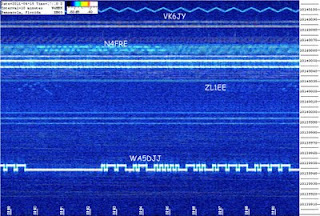The main requirement it that the frequency of the receiver be controlled by a single master crystal as in the TS-440. Older radios with multiple crystals used for the various hetrodyning stages will be too awkward to adapt because a separate controller would be required for each one.*
The TS-440 is actually pretty challenging with respect to cramped quarters. The crystal is located in the middle deck of a stack of 3 PC boards with very little room for the compact sleeve that fits around the xtal....but it just works. Figure 1 shows what we're up against.
| Figure 1. Location of master crystal in the TS-440 |
The front of the rig is at the top of the photograph. Note the upper deck has been swung up to allow access to the middle deck where the crystal is located. The small chassis to the right contains he outboard temperature control circuitry. The cable connecting the two is a 4-conductor type from an old modem line.
| Figure 2. Close-up of Copper Sleeve Installed on Crystal |
Figure 2 is a closer view of the crystal location showing the copper sleeve installed. The heating resistors are on the left and right sides of the sleeve and if you look carefully you can see the TO-92 case of the LM35 in between. Note how close the crystal is to the shield of one of the PLL's...there is only a few mm spacing and no room for Styrofoam insulation as I have used with other TC's.
| Figure 3. Case Closed |
Figure 3 shows the case closed back up. Along the front of the controller are, L to R, temperature control pot, LED indicator, Temp or drive voltage switch and RCA plug for voltmeter. Figure 4 shows everything set up and operating. When power is first applied to the controller the LED glows brightly then gradually dims to a steady value to indicate regulation.
| Figure 4. System in Operation |
How does it perform? Bottom line, the frequency is stable enough for long duration stacking work up to 6 hours. When I monitor WWV the variation over a day is +/- 1 Hz when the wx is nice enough to leave the windows open 24/7 and outdoor temperatures vary by 15 degrees F. I adjusted the operating temperature to 125 deg F (52 C) which is the measured turn-around point for the TS-440 crystal. I determined this by varying the temperature with the pot and noting the point where temperature quits decreasing and starts increasing again....see Part 1. The ceiling fan has a noticeable effect on temperature variations and when I'm really serious about stacking I leave it on low speed to keep the air in the shack well stirred.
de w4hbk



